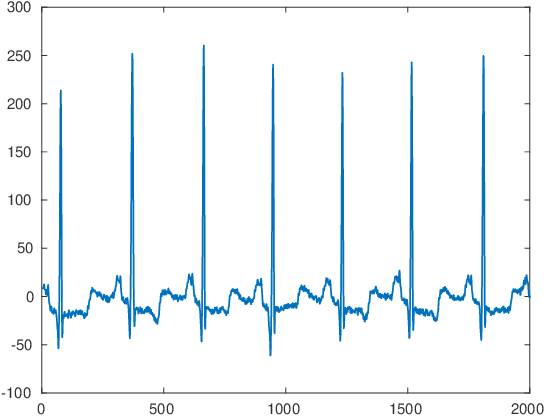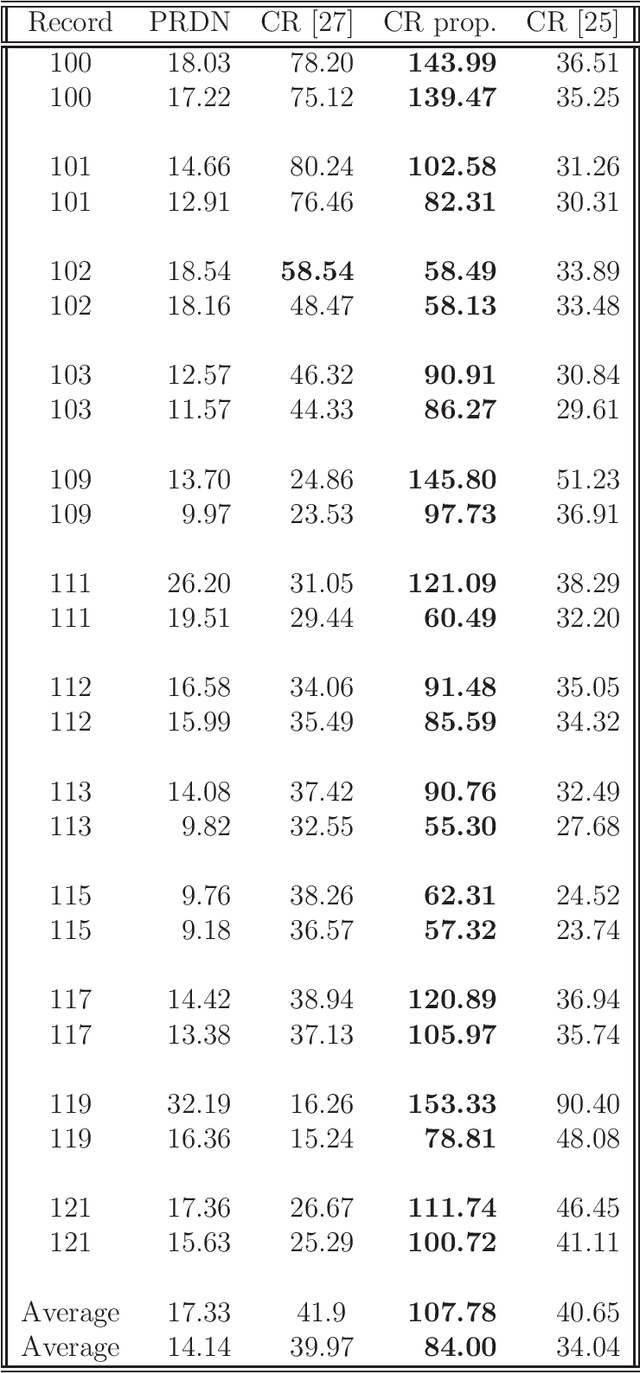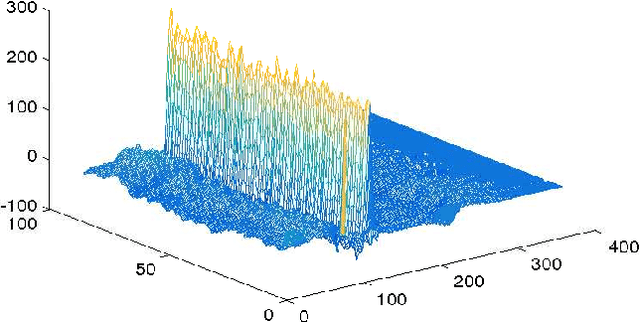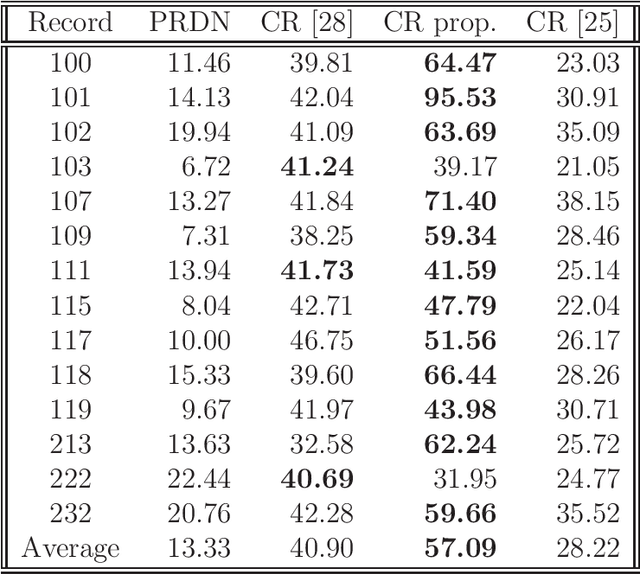Laura Rebollo-Neira
Simultaneous Optimized Orthogonal Matching Pursuit with Application to ECG Compression
Jun 05, 2024



Abstract:A greedy pursuit strategy which finds a common basis for approximating a set of similar signals is proposed. The strategy extends the Optimized Orthogonal Matching Pursuit approach to selecting the subspace containing the approximation of all the signals in the set. The method, called Simultaneous Optimized Orthogonal Matching Pursuit, is stepwise optimal in the sense of minimizing at each iteration the mean error norm of the joint approximation. When applied to compression of electrocardiograms, significant gains over other transformation based compression techniques are demonstrated on the MIT-BIH Arrhythmia dataset.
Sparsity based morphological identification of heartbeats
Jan 16, 2023



Abstract:The electrocardiogram (ECG) is one of the most common primary tests to evaluate the health of the heart. Reliable automatic interpretation of ECG records is crucial to the goal of improving public health. It can enable a safe inexpensive monitoring. This work presents a new methodology for morphological identification of heartbeats, which is placed outside the usual machine learning framework. The proposal considers the sparsity of the representation of a heartbeat as a parameter for morphological identification. The approach involves greedy algorithms for selecting elements from redundant dictionaries, which should be previously learnt from examples of the classes to be identified. Using different metrics of sparsity, the dictionary rendering the smallest sparsity value, for the equivalent approximation quality of a new heartbeat, classifies the morphology of that beat. This study focuses on a procedure of learning the dictionaries for representing heartbeats and compares several metrics of sparsity for morphological identification on the basis of those metrics. The suitability of the method is illustrated by binary differentiation of Normal and Ventricular heartbeats in the MIT-BIH Arrhythmia data set. In general classification 99.7% of the Normal beats and 97.6% of the Ventricular beats in the testing sets are correctly identified. In interpatient assessment 91.8% of the Normal beats and 91.0% of Ventricular beats are correctly identified. Even more important than these scores is the fact that they are produced on the bases of a single parameter. The numerical tests, designed to emphasise the interpretability and reliability of the approach, demonstrate the potential of the method to contribute towards the development of a well grounded expert system for classification of heartbeats in ECG records.
Enhancing sparse representation of color images by cross channel transformation
May 14, 2021



Abstract:Transformations for enhancing sparsity in the approximation of color images by 2D atomic decomposition are discussed. The sparsity is firstly considered with respect to the most significant coefficients in the wavelet decomposition of the color image. The discrete cosine transform is singled out as an effective transformation for this purpose. The enhanced feature is further exploited by approximating the transformed arrays using an effective greedy strategy with a separable highly redundant dictionary. The relevance of the achieved sparsity is illustrated by a simple encoding procedure. On a set of typical test images the compression at high quality recovery is shown to significantly improve upon JPEG and WebP formats. The results are competitive with those produced by the JPEG2000 standard.
Analysis of a low memory implementation of the Orthogonal Matching Pursuit greedy strategy
Nov 12, 2017



Abstract:The convergence and numerical analysis of a low memory implementation of the Orthogonal Matching Pursuit greedy strategy, which is termed Self Projected Matching Pursuit, is presented. This approach provides an iterative way of solving the least squares problem with much less storage requirement than direct linear algebra techniques. Hence, it is appropriate for solving large linear systems. Furthermore, the low memory requirement of the method suits it for massive parallelization, via Graphics Processing Unit, to tackle systems which can be broken into a large number of subsystems of much smaller dimension.
Effective sparse representation of X-Ray medical images
Nov 11, 2016



Abstract:Effective sparse representation of X-Ray medical images within the context of data reduction is considered. The proposed framework is shown to render an enormous reduction in the cardinality of the data set required to represent this class of images at very good quality. The particularity of the approach is that it can be implemented at very competitive processing time and low memory requirements
Hierarchized block wise image approximation by greedy pursuit strategies
Aug 27, 2013


Abstract:An approach for effective implementation of greedy selection methodologies, to approximate an image partitioned into blocks, is proposed. The method is specially designed for approximating partitions on a transformed image. It evolves by selecting, at each iteration step, i) the elements for approximating each of the blocks partitioning the image and ii) the hierarchized sequence in which the blocks are approximated to reach the required global condition on sparsity.
Sparsity and `Something Else': An Approach to Encrypted Image Folding
Sep 12, 2012



Abstract:A property of sparse representations in relation to their capacity for information storage is discussed. It is shown that this feature can be used for an application that we term Encrypted Image Folding. The proposed procedure is realizable through any suitable transformation. In particular, in this paper we illustrate the approach by recourse to the Discrete Cosine Transform and a combination of redundant Cosine and Dirac dictionaries. The main advantage of the proposed technique is that both storage and encryption can be achieved simultaneously using simple processing steps.
* Revised manuscript- Software for implementing the Encrypted Image Folding proposed in this paper is available on http://www.nonlinear-approx.info/
Sparse Representation of Astronomical Images
Sep 12, 2012



Abstract:Sparse representation of astronomical images is discussed. It is shown that a significant gain in sparsity is achieved when particular mixed dictionaries are used for approximating these types of images with greedy selection strategies. Experiments are conducted to confirm: i)Effectiveness at producing sparse representations. ii)Competitiveness, with respect to the time required to process large images.The latter is a consequence of the suitability of the proposed dictionaries for approximating images in partitions of small blocks.This feature makes it possible to apply the effective greedy selection technique Orthogonal Matching Pursuit, up to some block size. For blocks exceeding that size a refinement of the original Matching Pursuit approach is considered. The resulting method is termed Self Projected Matching Pursuit, because is shown to be effective for implementing, via Matching Pursuit itself, the optional back-projection intermediate steps in that approach.
Sparse image representation by discrete cosine/spline based dictionaries
Sep 07, 2009



Abstract:Mixed dictionaries generated by cosine and B-spline functions are considered. It is shown that, by highly nonlinear approaches such as Orthogonal Matching Pursuit, the discrete version of the proposed dictionaries yields a significant gain in the sparsity of an image representation.
 Add to Chrome
Add to Chrome Add to Firefox
Add to Firefox Add to Edge
Add to Edge